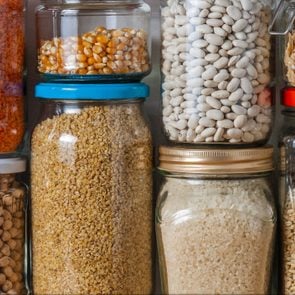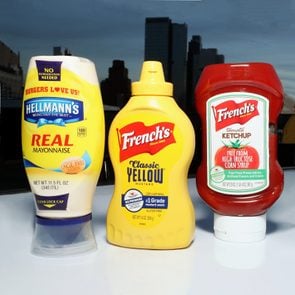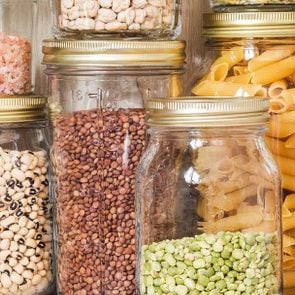10 Clever Pantry Storage Ideas That Maximize Space and Efficiency
Updated: Mar. 15, 2024
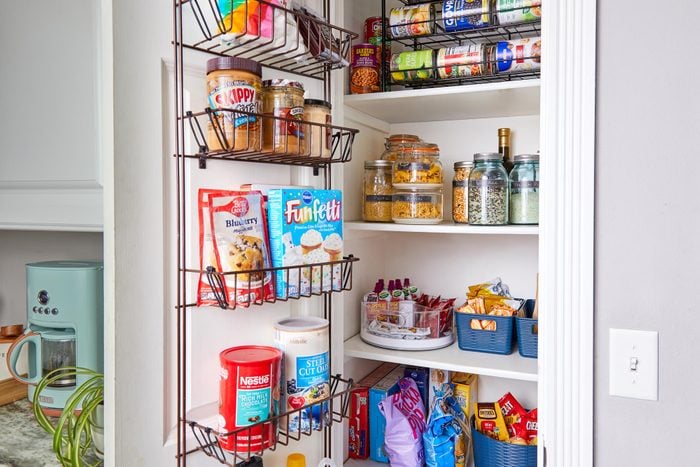
Want to maximize your pantry? It's all about small-space storage solutions. These savvy pantry storage ideas will help you stay clutter free.
Of all the cabinets and storage areas in your kitchen, the pantry likely gets the most traffic. As the home to most of your non-perishable food, a well-organized pantry can mean a more pleasant cooking and eating experience—and less food wasted because you can actually see what you have on hand. From dry goods, such as flour, rice and pasta, to canned goods, snacks, chips and breakfast bars, pantry staples deserve the proper repository. So we’ve rounded up some of the best pantry storage ideas to maximize your kitchen organization.
Once you’ve optimized your cabinet storage, fridge organization and kitchen counter clutter, you’ll want to head to the pantry. Take inventory of the items in your pantry—which products are regularly stocked? Which categories take up the most space? Do you buy in bulk? To start organizing your pantry, you’ll want to remove everything from your shelves, then read on to discover our favorite pantry storage ideas.
Get Reader’s Digest’s Read Up newsletter for organization, cleaning, travel, tech and fun facts all week long.
1. Use baskets and bins
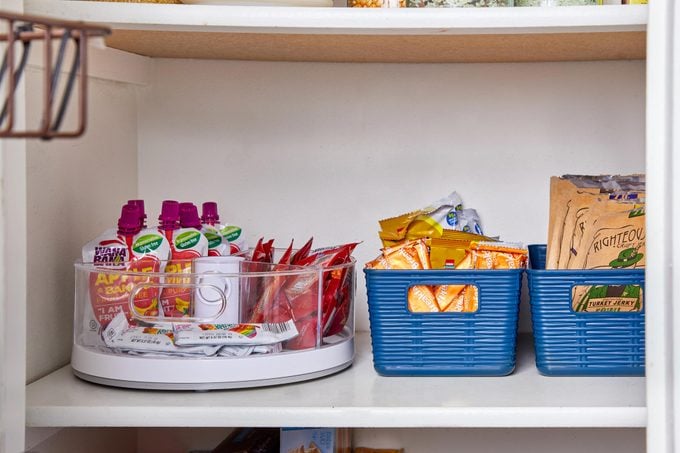
Instead of piling all your food individually onto the pantry shelves, use baskets or bins to corral your items by type or category. This will give everything a defined place in your pantry—plus, it helps keep it all from toppling over. Don’t be afraid to mix and match based on the contents. For food you’d like to see, go for clear plastic bins or wire baskets. For things you’d like hidden, opaque bins or woven baskets are best. And don’t forget the things you’ve bought in bulk. Wooden crates at the bottom or top of your pantry can host excess paper towels, trash bags, household supplies and more.
2. Store dry goods in uniform containers
The most awe-inspiring pantries likely have one thing in common: There is no store-bought packaging in sight. Empty products such as cereal, pasta, nuts and seeds, chips and more into matching plastic or glass food storage containers. If you want your pantry to have a uniform look—and likely give your food a longer shelf life—this is a great strategy.
3. Adjust your shelving height
Before you start refilling the pantry with newly organized food items, see if you can adjust the heights of your shelves. Shelves are typically arranged to have the same amount of space in between each, but not all your items or containers are going to work with that spacing.
Think about what you want to put where. The middle shelves are the easiest to not only see, but also access, so they should feature your most-used pantry staples. Consider which items you’d like in sight on lower shelves, such as easy-to-reach kids’ snacks or healthy grab-and-go items. If you buy in bulk, then the top shelves might need to be adjusted to fit those extra paper towels or hardly used appliances. Adjust the heights accordingly to maximize your space.
4. Store like with like
Pantry storage ideas should feel intuitive. For this reason, you don’t want to put your coffee on one shelf and tea on another. Keep your flour close to your sugar and your canned beans by your canned tomatoes. Keeping items that you use together close to each other will make it easier for you—and for any little ones in your home—to put things back where they came from and keep your pantry neat in the long run.
5. Use labels
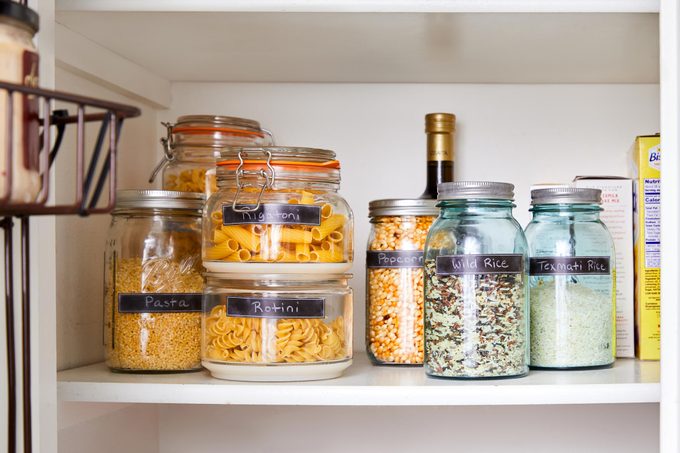
Adding labels to your storage bins, glass storage containers or shelves is a great way to enhance pantry organization and make sure your family members follow suit and return items to their place.
6. Utilize back-of-the-door space
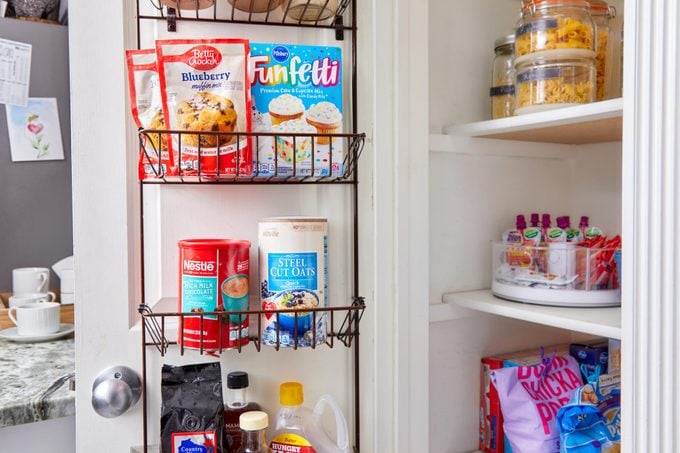
If the doors of your pantry don’t rest flush against the shelves, consider utilizing an over-the-door pantry organizer. These narrow baskets are a great spice storage idea, a place to house condiments, oil and vinegar or even cans. You could also hang or install hooks on the back of the pantry door and use it as a place to organize pots and pans, kitchen towels, aprons and more.
7. Add pull-out drawers
The bottom pantry shelves can be difficult to reach unless you get down on your hands and knees to grab items. For this reason, lower shelving space is often underutilized. One easy-to-add pantry storage idea: Add pull-out drawers to the bottom shelf (these are also a great kitchen cabinet organizer). They are easy to install and will guarantee you maximize that hard-to-reach space.
8. Consider a can rack
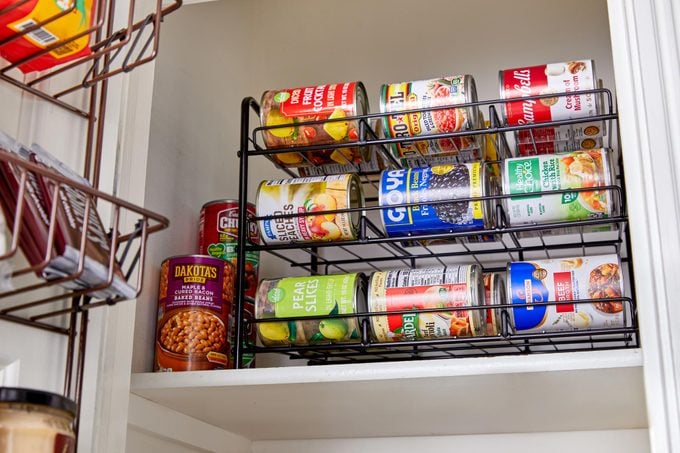
At first glance, you might not think you need organizational help for your canned goods. After all, they can stand by themselves and stack on top of one another—but we all know that cans get shoved so far back we end up buying duplicates we don’t need. Enter a stackable can rack and dispenser, which can sit on a shelf in your pantry and give you easy access to all those canned goods.
9. Spin some turntables
No, not the record-playing kind—the ones that can house spices, bottles, sauces, pouches, snacks and more, providing you with easy access to all. If you find that you often lose foods to the depths of your pantry well past the expiration date, this pantry storage idea is for you. Look for ones with small compartments that allow you to stand things like snack bars vertically, housing more of them in a smaller space. Bonus: A turntable is also a great under-sink organizer for cleaning products.
10. Hang a pegboard or hooks

If you have a walk-in pantry or butler’s pantry, there may be empty walls without shelves. Maximize this space by hanging a pegboard or rows of hooks from which you can dangle anything from baskets that hold potatoes and onions, to pots and pans, kitchen utensils or reusable grocery bags. You can also add connected containers that store trash bags, aluminum foil, parchment paper and other kitchen tools.

